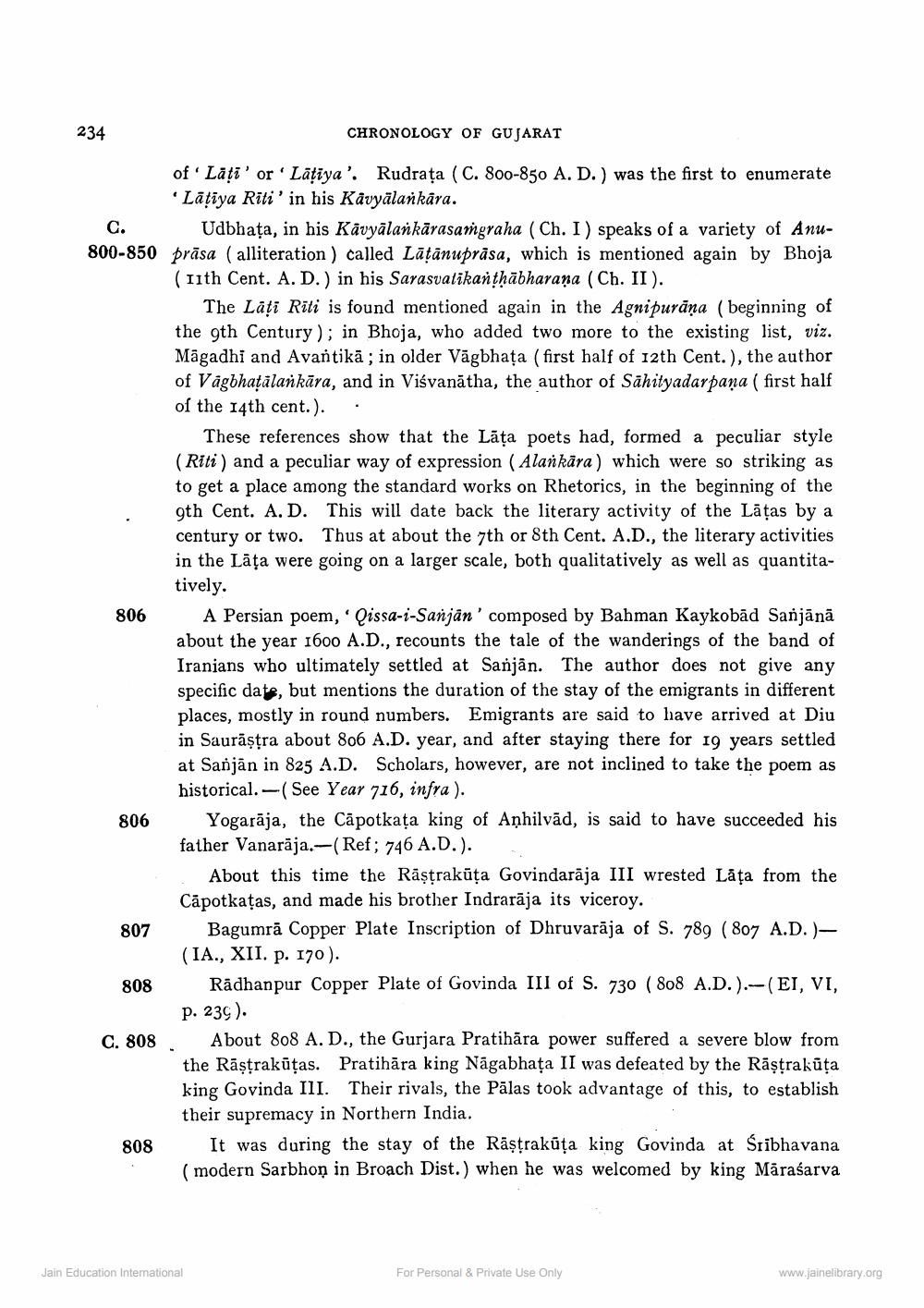________________
234
C.
Udbhata, in his Kävyälankärasaṁgraha (Ch. I) speaks of a variety of Anu800-850 prasa (alliteration) called Latanuprāsa, which is mentioned again by Bhoja
(11th Cent. A. D.) in his Sarasvatikantḥābharaṇa (Ch. II).
806
806
807
808
C. 808
CHRONOLOGY OF GUJARAT
of Lati' or Latiya'. Rudrata (C. 800-850 A. D.) was the first to enumerate 'Latiya Riti in his Kavyalankara.
808
The Lati Rili is found mentioned again in the Agnipurāna (beginning of the 9th Century); in Bhoja, who added two more to the existing list, viz. Magadhi and Avantika; in older Vägbhața (first half of 12th Cent.), the author of Vägbhațalankara, and in Viśvanatha, the author of Sahityadarpana (first half of the 14th cent.).
These references show that the Lața poets had, formed a peculiar style (Riti) and a peculiar way of expression (Alankara) which were so striking as to get a place among the standard works on Rhetorics, in the beginning of the 9th Cent. A. D. This will date back the literary activity of the Laṭas by a century or two. Thus at about the 7th or 8th Cent. A.D., the literary activities in the Lata were going on a larger scale, both qualitatively as well as quantitatively.
A Persian poem, ' Qissa-i-Sanjan' composed by Bahman Kaykobåd Sanjānā about the year 1600 A.D., recounts the tale of the wanderings of the band of Iranians who ultimately settled at Sanjan. The author does not give any specific date, but mentions the duration of the stay of the emigrants in different places, mostly in round numbers. Emigrants are said to have arrived at Diu. in Saurăstra about 806 A.D. year, and after staying there for 19 years settled at Sanjan in 825 A.D. Scholars, however, are not inclined to take the poem as historical.(See Year 716, infra).
Yogaraja, the Capotkața king of Aphilväd, is said to have succeeded his father Vanaraja.-(Ref; 746 A.D.).
About this time the Râştraküța Govindaraja III wrested Lata from the Capotkatas, and made his brother Indrarāja its viceroy.
Bagumra Copper Plate Inscription of Dhruvaraja of S. 789 (807 A.D.)(IA., XII. p. 170).
Radhanpur Copper Plate of Govinda III of S. 730 (808 A.D.).-(EI, VI, p. 236).
About 808 A. D., the Gurjara Pratihāra power suffered a severe blow from the Räṣṭrakūtas. Pratihāra king Nagabhața II was defeated by the Rāṣṭrakūṭa king Govinda III. Their rivals, the Pālas took advantage of this, to establish their supremacy in Northern India.
It was during the stay of the Rastrakūta king Govinda at Sribhavana. (modern Sarbhon in Broach Dist.) when he was welcomed by king Māraśarva
Jain Education International
For Personal & Private Use Only
www.jainelibrary.org




